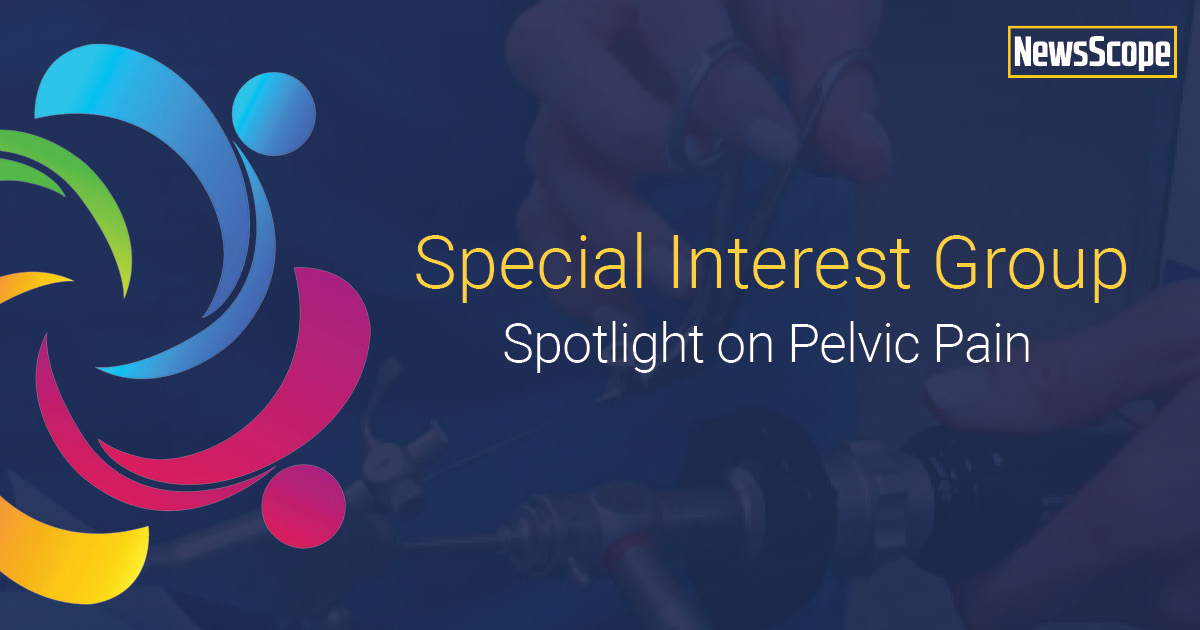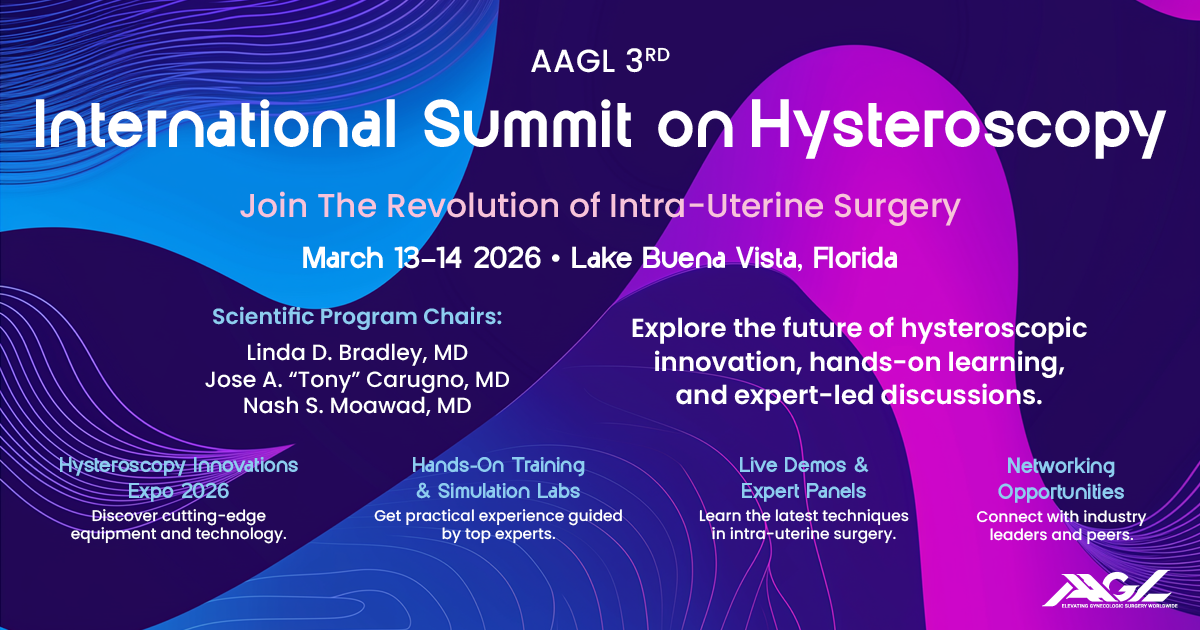Spotlight On: Pelvic Pain

May is Pelvic Pain Awareness month and we are spotlighting articles and videos from the Pelvic Pain Special Interest Group led by Ashley Gubbels, MD, Chair and Timothy Deimling, MD, Vice Chair. SurgeryU features hundreds of high-definition surgical videos from surgeons from around the world. Access to SurgeryU is one of the many benefits included in your AAGL membership. If you would like access to these videos, CME programming, JMIG Journal, and member-only discounts on meetings, join AAGL today. These videos are being made available with public access for a limited time. Click here to join AAGL!
Video Selections by Ashley Gubbels, MD
Vestibulectomy With Vaginal Advancement for Treatment of Vestibulodynia is a common pain condition affecting 10-15% of women. This video is important as most physicians have not been exposed to vestibulectomy and this procedure can be very effective for women who fail conservative options.
Ovarian Remnant Resections can be extremely difficult. Understanding retroperitoneal anatomy and how to adequately remove the residual ovarian tissue is vital for patient safety and outcome.
Author Ashley Gubbels, MD, is chair of the AAGL Pelvic Pain Special Interest Group and a Surgeon at Creighton University School of Medicine/St Joseph’s Hospital in Phoenix, AZ.
Article: Most Difficult Case Presentation: Severe Neuropathic Pain Following LAVH by Ashley Gubbels, MD and Nicole Afuape, MD
Chronic pelvic pain is frequently due to overlapping conditions which may be related anatomically or functionally. Understanding of pelvic and neuroanatomy (neuropelveology) can aid clinicians in determining the etiology of pain and appropriate treatment.
We present a case of a 46yo who underwent a LAVH for pelvic pain which she attributed to endometriosis. She had a longstanding history of pelvic pain since age 17 and two prior laparoscopies for endometriosis. Her preoperative symptoms consisted of pelvic heaviness and pain which had not improved with hormonal management. She underwent an LAVH and McCall culdoplasty. Operative note reported ligation of dilated vessels but without specification of location. The procedure was complicated by a right ureteral injury 2cm below the pelvic brim repaired by midline laparotomy and reimplantation. The culdoplasty suture was reportedly removed when the ureteral injury was identified. A ureteral stent and Foley catheter were left in place postoperatively.
The patient reported waking with pain in the bilateral posterior thigh, left ischial tuberosity, and vulva which she described as a constant nerve pain along with a separate LLQ pain which radiated to her low back. She was unable to sit postoperatively and spent 6 weeks semi-recumbent. Transient bladder and right abdominal pain improved after removal of the ureteral stent. Her deep LLQ /low back pain persisted along with neuropathic pain down her posterior thigh. This pain radiated to the back of the knee and occasionally down to her heel. She denied any persistent genital pain. Sitting became associated with calf pulsation and radiation into her sacrum. She also reported a pulsating sensation in the bilateral genitofemoral folds. Pain improved with laying down but was worse when sitting or standing.
Patient underwent pudendal nerve block at the ischial spine without relief and was referred to physical therapy. Upon presentation to our office, she was found to have an epithelialized suture band traversing the posterior vagina and reproduction of symptoms with palpation along with a hypertonic pelvic floor. Overall examination was non-localizing due to the diffuse extent of her pain. The suture band was excised. Evaluation 1 week later showed decrease in LLQ pain and some possible improvement in her thigh pain. MRI/neurogram was negative for obvious pudendal/sacral nerve root pathology. Vascular ultrasound showed bilateral ovarian vein reflux and 50% narrowing of the left renal vein. A CT-guided pudendal nerve block at the ischial spine and Alcock’s canal was diagnostic of pudendal neuralgia. Concurrent venogram did not show evidence of venous congestion. Patient started physical therapy with slow improvement. Repeat examination 2 months later showed marked improvement of her pelvic floor tension. The sacrospinous ligament remained tender though with negative Tinel’s sign. Palpation of the left vaginal apex was tender with a 3-4mm nodule which recreated her LLQ/sacral pain. Vaginal cuff injection decreased tenderness but ultimately flared her LLQ, ischial tuberosity, and posterior thigh pain.
She underwent robotic left pudendal neurolysis and vaginal cuff revision. Intraoperatively increased visible fullness of the left parametria was noted compared to the right. No endometriosis was noted. Pudendal decompression demonstrated a small bridging vein crossing over above the level of the sacrospinous ligament but no other clear pathology of the nerve. Cuff revision was performed ensuring removal of the nodule and required ureterolysis to the bladder insertion with care to minimize disruption the inferior hypogastric plexus. Patient awoke with minimal discomfort. Pathology revealed cuff neuroma. She is 1 week postop and too early in her course to assess overall response.
Authors: Ashley Gubbels, MD, Chair of AAGL Pelvic Pain SIG and Assistant Professor, Creighton School of Medicine-Phoenix; Nicole Afuape, MD, Assistant Professor, Creighton School of Medicine-Phoenix; Mario Castellanos, MD, Professor, Creighton School of Medicine-Phoenix.
Image 1 -Pelvis showing ureteral re-implantation and fullness on left

Image 2: L pudendal nerve

Image 3: Vaginal cuff

Technology Review: Pulsed Radiofrequency Ablation for the Treatment of Pudendal Neuralgia by Nicole Afuape, MD, and Ashley Gubbels, MD
Neuropathic pain can be difficult to treat, and medications are associated with significant side effects. Nerve blocks can be beneficial for some but rarely result in long- term relief. In patients with pain within a single peripheral nerve distribution, radiofrequency ablation can provide moderate duration of relief. Pulsed radiofrequency ablation (PRFA) is used frequently in the pain management of various conditions, most commonly neck and back pain. PRFA has been successfully used to manage pudendal neuralgia.
A case series review by Krijnen et al.1 evaluated the response of patients meeting Nantes criteria for pudendal neuralgia who had failed non-invasive treatments and nerve blocks. Seventy-nine percent of patients reported themselves “(very) much better” at 3 months. Therapy was repeated every 2-6 months (range 2-71 procedures per patient) and long-term success was quoted as 89% (mean follow up 4.4 years). These rates are comparable to Fang et al.2 who performed a RCT with 3 month follow up of 77 patients in which 92.1% reported effectiveness compared to 35.9% in the nerve block group. Comparatively, success rates of pudendal nerve blocks are estimated at 11-13%3 and surgical decompression at 60%.4 Based on studies in chronic neck and back pain however, relief from PRFA is of moderate duration (typically 6-12 months) and may need to be repeated.
The exact mechanism of PRFA is unknown but it has been postulated that the temporary electromagnetic field created results in cellular changes that alters transmission of pain signals by damaging the ultrastructural components of the axons including mitochondrial membranes and microfilaments. Damage impacts smaller diameter neurons such as A-delta and C fibers most significantly but is technically non-selective. The latent period between pulses allows heat to dissipate avoiding the neurodestructive temperatures that occur with conventional/continuous RFA (CRFA). As these procedures do not select for nociceptive fibers, CRFA is preferentially avoided in nerves with motor function. While the benefit of PRFA is less pain (compared to CRFA), the disadvantage is shorter duration of relief requiring repeated procedures. Data specific to efficacy in pudendal neuralgia is limited by the scarcity of randomized controlled trials.
Pudendal PRFA is a reasonable therapeutic option for patients with a positive analgesic response to a pudendal nerve block. However, patients should be informed that the procedure may need to be repeated at variable frequency.
Authors: Nicole Afuape, MD, and Ashley Gubbels, MD, AAGL Pelvic Pain SIG and Assistant Professors at Creighton School of Medicine in Phoenix, Arizona.
References:
- Krijnen EA, Schweitzer KJ, van Wijck AJM, Withagen MIJ. Pulsed Radiofrequency of Pudendal Nerve for Treatment in Patients with Pudendal Neuralgia. A Case Series with Long-Term Follow-Up. Pain Pract. 2021;21(6):703-707.
- Fang H, Zhang J, Yang Y, Ye L, Wang X. Clinical effect and safety of pulsed radiofrequency treatment for pudendal neuralgia: a prospective, randomized controlled clinical trial. J Pain Res.2018; 11: 2367–2374.
- Labat JJ, Riant T, Lassaux A, Rioult B, Rabischong B, Khalfallah M, Volteau C, Leroi AM, Ploteau S. Adding corticosteroids to the pudendal nerve block for pudendal neuralgia: a randomised, double-blind, controlled trial. BJOG. 2017 Jan;124(2):251-260.
- Benson JT, Griffis K. Pudendal neuralgia, a severe pain syndrome. Am J Obstet Gynecol.2005;192:1663–1668.








